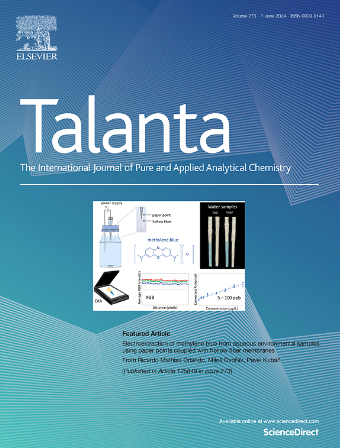Influence of electrode body material on the analytical behaviour of solid-contact ion-selective electrodes
IF 5.6
1区 化学
Q1 CHEMISTRY, ANALYTICAL
引用次数: 0
Abstract
Different materials such as PVC, PTFE, or PEEK are commonly used as the external body of solid-contact ion-selective electrodes (SC-ISEs). So far, the possible effect of these electrode body materials on the analytical behaviour of SC-ISEs has not been considered. In this study, we demonstrate that the selectivity of SC-ISEs can be strongly influenced by the type of the material used as the electrode body. To investigate this effect, different characterization techniques such as potentiometry, optical microscopy, NMR, and FTIR were used. Interestingly, the electrode body material significantly influences the selectivity in the case of bicarbonate SC-ISEs (anionic ISE), while the effect is negligible in the case of potassium SC-ISEs (cationic ISE).
Results from NMR and FTIR indicate that some additives or compounds may migrate into the plasticised PVC membrane thereby influencing the selectivity of SC-ISEs. However, one cannot exclude the opposite process where membrane components will diffuse into the PVC electrode body. This can be quite a complex process as not only the chemical composition of the PVC rod would play a role but also its physical properties such as porosity or tortuosity.

求助全文
约1分钟内获得全文
求助全文
来源期刊

Talanta
化学-分析化学
CiteScore
12.30
自引率
4.90%
发文量
861
审稿时长
29 days
期刊介绍:
Talanta provides a forum for the publication of original research papers, short communications, and critical reviews in all branches of pure and applied analytical chemistry. Papers are evaluated based on established guidelines, including the fundamental nature of the study, scientific novelty, substantial improvement or advantage over existing technology or methods, and demonstrated analytical applicability. Original research papers on fundamental studies, and on novel sensor and instrumentation developments, are encouraged. Novel or improved applications in areas such as clinical and biological chemistry, environmental analysis, geochemistry, materials science and engineering, and analytical platforms for omics development are welcome.
Analytical performance of methods should be determined, including interference and matrix effects, and methods should be validated by comparison with a standard method, or analysis of a certified reference material. Simple spiking recoveries may not be sufficient. The developed method should especially comprise information on selectivity, sensitivity, detection limits, accuracy, and reliability. However, applying official validation or robustness studies to a routine method or technique does not necessarily constitute novelty. Proper statistical treatment of the data should be provided. Relevant literature should be cited, including related publications by the authors, and authors should discuss how their proposed methodology compares with previously reported methods.
 求助内容:
求助内容: 应助结果提醒方式:
应助结果提醒方式:


